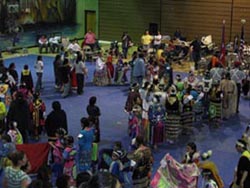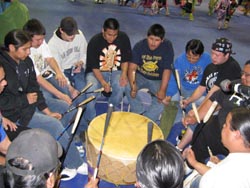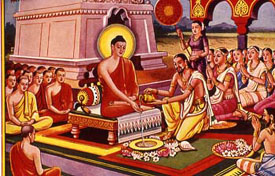
Red Cloud High School
Nature and Spirituality in the Himalayas: A Comparative Approach
| Home |
| Himalayan And Lakota Culture |
| Nature Literature |
| Comparative Mythology |
| Links |
| Bibliography |
| Biography |
Himalayan and Lakota Culture: Cultural Practices
Lakota Sweatlodge/ Tibetan Purification Rites The Lakota and the people of the Himalayas have many similar cultural practices. A major Lakota ritual is the sweatlodge (inipi). The sweatlodge is a ceremony of purification and prayer and uses the natural elements of the world: earth, water, fire, and air. "The willows which make the frame of the sweat lodge are set up in such a way that they mark the four quarters of the universe; thus, the whole lodge is the universe in an image, and the two-legged, four-legged, and winged peoples, and all things of the world are contained within it, for all these peoples and things too must be purified before they can send a voice to Wakan-Tanka." ~ Black Elk in The Sacred Pipe: Black Elk's Account of the Seven Rites of the Oglala Sioux, pg. 32 The sweatlodge is likened to the womb of the earth, and the participants emerge from the ritual rejuvenated and renewed. The sweatlodge is divided into four rounds of prayer and sacred song. Participants humbly crawl into the lodge while stating, "mitakuye oyasin". "When we use the water in the sweat lodge we should think of Wakan-Tanka who is always flowing, giving His power and life to everything; we should even be as water which is lower than all things, yet stronger even than the rock." ~ Black Elk in The Sacred Pipe, pg. 31 Black Elk's description of water has a striking parallel to another Asian religious tradition with a strong ecological emphasis, Taoism. This is evidence from a passage by the Taoist sage Lao-tzu: "In the whole world there is nothing so soft and yielding as water, and yet nothing prevails better in attacking what is hard and strong. It is this quality of not being hard and strong which makes its tasks easy. The soft overcomes the hard. The weak overcomes the strong. In the whole world there are none who do not know this, and yet none are able to practise it. Therefore a sage has said: It is he who accepts the dirt of a state who is lord over its altars. He who takes upon himself the evils of a state can become ruler over the whole land." ~ Lao-tzu, quoted in The Wisdom of the Taoists by D. Howard Smith, pg. 56 The Lakota sweatlodge can be summarized as a ritual of purification and prayer. This ritual is often used in preparation for other spiritual ceremonies, such as the hanbleceya (vision quest), yuwipi (healing ceremony), and wi-wangyang wacipi (sundance). The sweatlodge can be paralleled to Buddhist rituals. "Entering the darkness of the Stonepeople's Lodge, crawling on one's knees through the low door into the womb of the lodge, being cleansed by the four elements of earth, water, air, and fire, renew the experience of relatedness. One medicine man told me: 'We go into that sacred Lodge to purify ourselves. We go in there to see just who we really are, and in the darkness, to see how we go on this Earth. We make ourselves really humble, like the littlest creature, and we pray to Spirit that we may be healed, that all may be healed. We see that we are not separate from anything. We are all in this together. And we always say all my relations.' This prayer and its sentiment is quite similar to the Buddhist dedication of merit to all sentient beings, and to the bodhisattva vow, as well." ~ Joan Halifax, "The Third Body: Buddhism, Ecology, and Deep Ecology" in Dharma Gaia: A Harvest of Essays in Buddhism and Ecology, pg. 26 The Lakota sweatlodge parallels the Tibetan Buddhist ritual of lhasang (literally, "higher purification offering"), a smoke and fire offering to the gods. This ritual is also one of purification and prayer. In this ritual, juniper is placed in a fire and the incense that rises is an offering to the gods. Offerings and prayers are made. "The purpose of the lhasang may be described as twofold. First, it is a ritual of purification, cleansing people and places of any obstructions, obstacles, and negative forces. The fire and the purifying smoke are held to embody a powerful energy that dispels the defilements and negativities of those present. Second, the lhasang is an empowerment in that it brings down blessings in the form of wisdom, efficacy, and power. Juniper is typically burned in the lhasang fire, and the fragrant smoke travels up to the heavens, attracting the higher beings of samsara and the enlightened ones; thus the smoke becomes a kind of passageway or lightning rod down which their blessings can descend, filling participants with a sense of well-being, understanding, and happiness." ~ Reginald A. Ray, Indestructible Truth: The Living Spirituality of Tibetan Buddhism, pg. 58 Lakota Sacred Songs/ Tibetan Mantra In the sweatlodge, yuwipi, and sundance ceremonies, Lakota sacred songs are sung. For the Lakota, their music has a sacred origin. Similarly, in India music started as an offering to the gods. Lakota sacred songs are often short verses frequently repeated. They can be paralleled to the Tibetan use of mantra, which are short phrases that are repeated and are believed to have spiritual power. Here is a video clip of a mantra chanted by a Tibetan nun: http://www.youtube.com/watch?v=kpNSI8fR7_Y Hanbleceya/ Buddhist Meditation Buddhists are well known fore their practice of meditation. The Lakota do not meditate formally in the Buddhist manner. However, a parallel can be made in the sacred rite of hanbleceya, the vision quest. In the hanbleceya (also called lamenting), the participant will go off onto a hill for a series of days without food or water. The participant seeks a vision, a message from the Great Spirit that will give guidance in his life. Often the vision comes in the form of animals or an aspect of nature. The participant's prayers, fasting, and contemplation can certainly be called a form of meditation. "Perhaps the most important reason for 'lamenting' is that it helps us to realize the oneness with all things, to know that all things are our relatives; and then in behalf of all things we pray to Wakan-Tanka that He may give to us knowledge of Him who is the source of all things, yet greater than all things." ~ Black Elk, in The Sacred Pipe, pg. 46 Medicine Man/ Medicine Buddha The Lakota person endowed with the spiritual power to run ceremonies is the medicine man (wicasa wakan). He is called as such because he is more than just a spiritual leader; in addition, he is also a healer. It is common for someone to seek a medicine man to ask for the healing of an ailment. The yuwipi is a healing ceremony and there are healing rounds in the sweatlodge. The medicine man usually possesses various herbs that have spiritual power. This parallels the shamanistic tradition of Tibet, where spirituality and healing are often complementary. It also parallels the spiritual teachings of the Buddha, who can be likened to a healer. The Buddha if often described as a healer: he diagnosed the sickness of humanity (desire--which causes suffering) and prescribed medicine to help us heal this ailment, a way to end suffering (the Eight-fold Path). Meanwhile, the Medicine Buddha is a significant emanation of the Buddha. " The Medicine Buddha, Bhaishajyaguru, was another popular Buddha image, a form representing the Buddha's ability to embody healing for all beings....The Buddhist belief in the value of healing through medicine coincided with the wish for long life, which extended the opportunity to achieve the process of understanding that would lead to enlightenment." ~ Robert E. Fischer, Art of Tibet, pg. 38 Here is a very informative website on the Medicine Buddha: http://www.dharma-haven.org/tibetan/medicine-buddha.htm Here is the Sutra of the Medicine Buddha: http://www.buddhanet.net/pdf_file/medbudsutra.pdf Sacrifice The Lakota sundance is a ritual of sacrifice and renewal of life. There are many rites of sacrifice in the traditions of Tibet and Nepal. The Lakota ritual of the buffalo kill, in which a buffalo is ritually killed and prayed to in thanksgiving for the buffalo's generosity to the people, parallels the fall festival to Durga in Nepal, in which buffalos are sacrificed. In both instances, the people recognize the sacredness of the animal and offer thanksgiving. Many interesting parallels can be made between the sacred buffalo (tatanka) of the Lakota and the sacred cow in India. Lakota Wiping of the Tears/ Buddhist Compassion Compassion is a foundation for Buddhism. Compassion is demonstrated in the Lakota ritual of the Wiping of the Tears, in which the community expresses compassion and consolation for those who recently lost a loved one. Buddhist compassion can be paralleled to the Lakota value of generosity. This value is perhaps best embodied in the Lakota giveaway, which is held at special occasions and features the giving away of many gifts to the community in thanksgiving for their aid and support. Generosity also reveals itself in the lavish feasts of the Lakota. These feasts are similar to the large feasts of the Newars in Kathmandu Valley. Here is a website that discusses the significance of food in Newari culture: http://web.comhem.se/~u18515267/CHAPTERIII.htm Food Offerings to the Spirits Generosity and compassion are also in both cultures in the offering of foods to spirits. Tibetan Buddhists offer food to pretas (hungry ghosts) out of compassion. Similarly, at the end of a ritual such as the sweatlodge, the Lakota will pray and leave out a plate of food for the spirits before eating. Likewise, the Hindu puja is a "feeding of the gods", which includes offerings that utilize the five senses. Offered items could include clothing, flowers, incense, mantras, and the like. Lakota Prayer Ties/ Tibetan Prayer Flags Tibetan prayer flags are made in the five sacred colors, with each color representing a natural element: blue (sky), white (clouds), red (fire), green (water), and yellow (earth). The purpose of these flags is to spread prayers throughout the land. "Prayer flags are rooted in the religious and astrological traditions of Tibetan Buddhist culture. Buddhist prayers and mantras written on these flags invoke ideals of compassion, wisdom, peace, and good fortune. They can also be adorned with various Buddhist and astrological symbols. In Tibet, they are flown outdoors in high places around monasteries, holy sites, shrines, and roof-tops of homes....As the flags flutter in the wind, Tibetans believe that the sacred windhorse, often pictures in the center of prayer flags, carries off the prayers of good wishes to benefit others." ~ Jonathan Garfunkel, Approaching Tibetan Studies: A Resource Handbook for Educators, pg. 18 Here is a website for more information on Tibetan prayer flags: http://www.prayerflags.com/ Likewise, the Lakota make prayer ties, which are strips of cloth in their sacred colors fills with pinches of tobacco. The Lakota pray with the sacred tobacco and then place a pinch of tobacco in each flag (which repesents all the directions). The prayer ties are often prayed with in the sweatlodge and subsequently hung in an auspicious spot in nature. For example, prayer ties are found in the area of Bear Butte, a sacred mountain and sight of prayer.
The Lakota were traditionally a warrior society, Some of their greatest warrior, like Crazy Horse and Sitting Bull, were also spiritual leaders. Likewise, the Shakyamuni Buddha had a background in the ways of a warrior. When the Shakyamuni Buddha was growing up, he was trained in a variety of disciplines, including the martial arts and swordsmanship. The Japanese especially have made the connection between Buddhism and the way of the warrior (bushido), as embodied by the samurai. There is also an interesting connection to the Shambhala concept of the warrior: http://www.livingearthgatherings.org/shambala.html http://www.dharma-haven.org/shambhala.html http://www.hopedance.org/archive/issue30a/articles/shambhala.htm Thunderbolts An important symbol in esoteric Buddhism (Vajrayana) is the vajra, the diamond-like thunderbolt. The vajra is a symbol of the piercing quality of mind that is developed through Buddhist meditation. Thunderbolt imagery is also present in Lakota spirituality, namely in the heyokas, the "thunder-dreamers". These are spiritual leaders who have received a vision of the thunders. They are a type of "sacred clown" or "contrary", as they do things everything backwards (compared to the general norms). Classroom Use Essay Questions: 1. Research the rituals of your own religious tradition or culture. How do they reflect the tradition/culture's worldview? 2. How do Lakota and Tibetan rituals reflect their own spiritual worldview? 3. Compare these traditions to the monotheistic rituals of Christianity/Judaism/Islam. What are the similarities and differences? Move on to Sacred Mountains |





 Warriors
Warriors